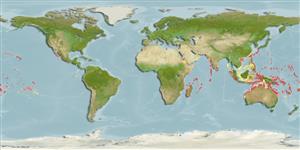Common names from other countries
>
Gobiiformes (Gobies) >
Microdesmidae (Wormfishes) > Ptereleotrinae
Etymology: Ptereleotris: Greek, pteron = wing, fin + The name of a Nile fish, eleotris (Ref. 45335).
More on author: Fowler.
Environment: milieu / climate zone / depth range / distribution range
Ecologia
marinhas associadas(os) a recifes; intervalo de profundidade 2 - 31 m (Ref. 1602), usually 2 - 4 m (Ref. 1602). Tropical; 22°C - 28°C (Ref. 27115); 30°N - 30°S
Indo-Pacific: Red Sea and islands in the western Indin Ocean (Ref. 528) to the Line and Marquesas Islands, north to the Ryukyu Islands, south to the southern Great Barrier Reef; Mariana and Marshall Islands in Micronesia.
Tamanho / Peso / Idade
Maturity: Lm ? range ? - ? cm
Max length : 12.0 cm SL macho/indeterminado; (Ref. 48637)
Espinhos dorsais (total) : 7; Raios dorsais (total) : 27 - 29; Espinhos anais: 1; Raios anais : 25 - 28; Vértebras: 26. Yellowish to greenish gray in color; lower half of eye to ventral of chin nearly enclosed by a broad blue-edged dark red to purple area; opercle with 2 diagonal bright blue bands; pectoral fin base with an orange-red bar broadly bordered with bright blue. Chin barbel followed by a median longitudinal fold. Fins yellowish; 2nd dorsal a median longitudinal row of blue spots.
This schooling species inhabits exposed seaward reefs in relatively shallow water, over hard bottoms. Usually many individuals occupy the same refuge. Found to be subjected to strong currents, where in small to large aggregations (Ref. 48637). Feeds on zooplanktons (Ref. 89972).
Ciclo de vida ou comportamento de acasalamento
Maturities | Reprodução | Spawnings | Egg(s) | Fecundities | Larvas
Randall, J.E. and D.F. Hoese, 1985. Revision of the Indo-Pacific dartfishes, genus Ptereleotris (Perciformes: Gobioidei). Indo-Pac. Fish. (7):36 p. (Ref. 528)
Status na Lista Vermelha da UICN (Ref. 130435)
CITES (Ref. 128078)
Not Evaluated
Ameaça para os humanos
Harmless
Uso pelos humanos
Pescarias: espécies comerciais; Aquário: Espécies comerciais
Ferramentas
Relatórios especiais
Baixar XML
Fontes da internet
Estimates based on models
Preferred temperature (Ref.
115969): 25 - 29.3, mean 28.2 (based on 2283 cells).
Índice de diversidade filogenética (Ref.
82804): PD
50 = 0.5000 [Uniqueness, from 0.5 = low to 2.0 = high].
Bayesian length-weight: a=0.00389 (0.00180 - 0.00842), b=3.12 (2.94 - 3.30), in cm Total Length, based on all LWR estimates for this body shape (Ref.
93245).
Nível Trófico (Ref.
69278): 3.4 ±0.45 se; based on food items.
Fishing Vulnerability (Ref.
59153): Low vulnerability (10 of 100).
